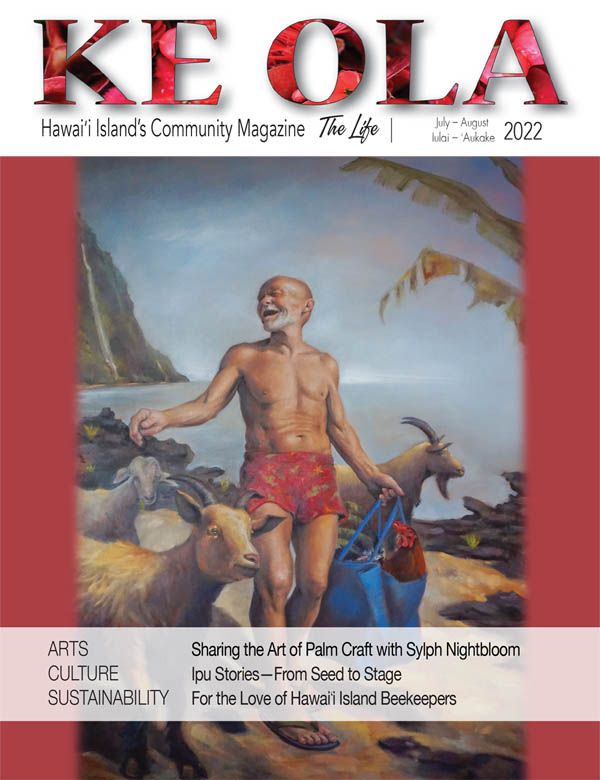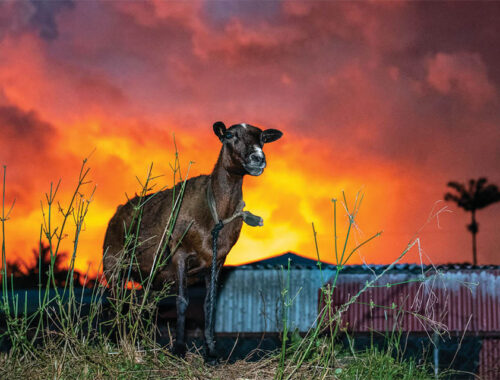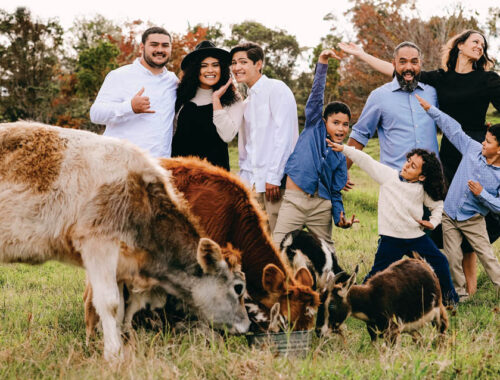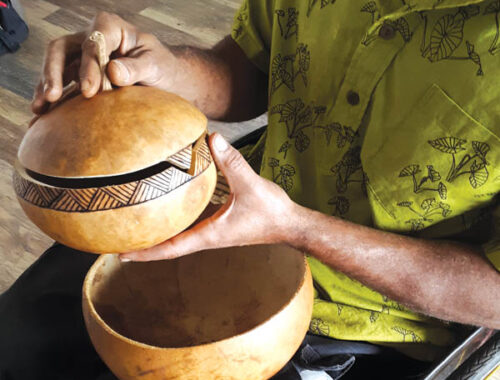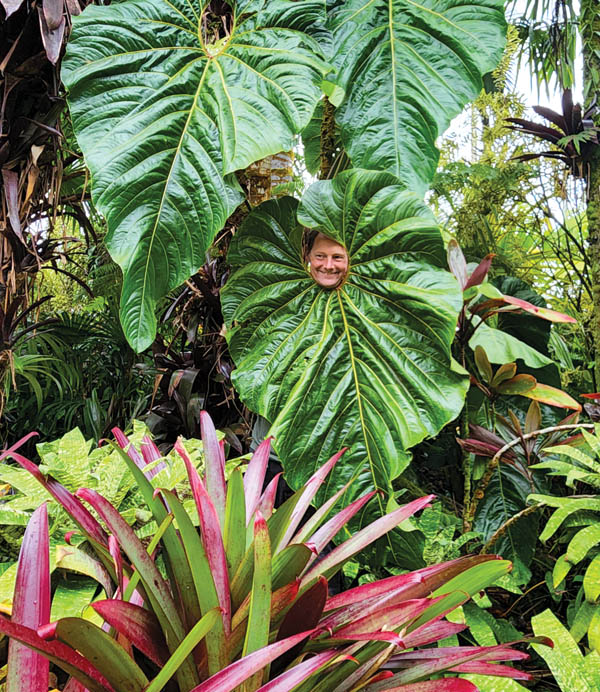
Casa de Las Palmas: Hilo’s Sanctuary for Rare and Endangered Palms
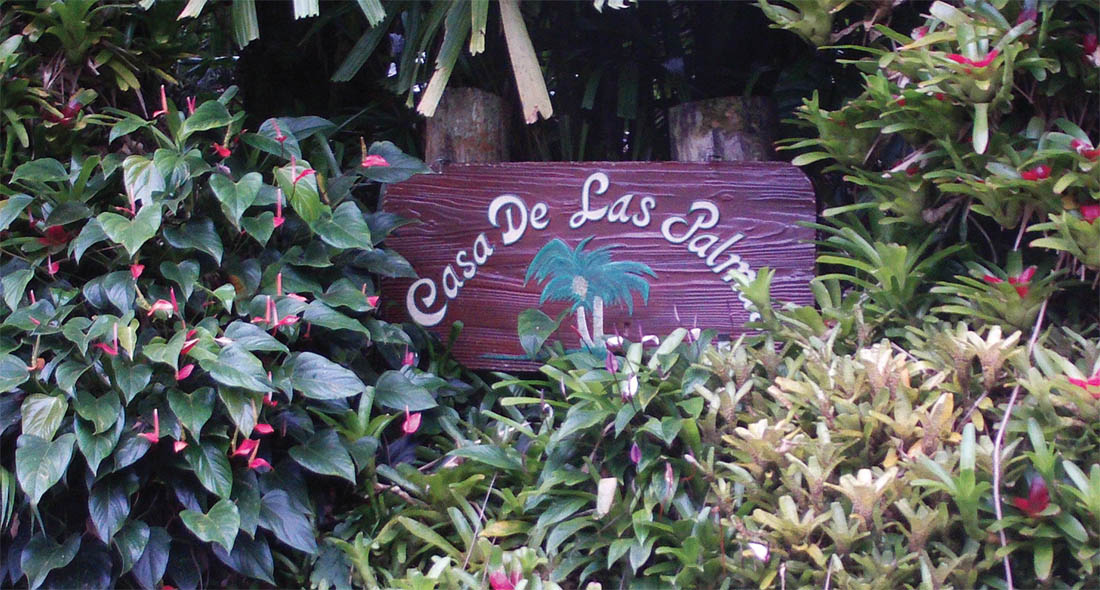
By Sara Stover
On an unassuming country road outside of Hilo, perched above the ancient waters of Waiākea Stream, grows a menagerie of rare and endangered palms. Before you even step foot onto the grounds of Casa de Las Palmas (Spanish for House of the Palms), stately palm trees usher you back in time to old Hawai‘i.
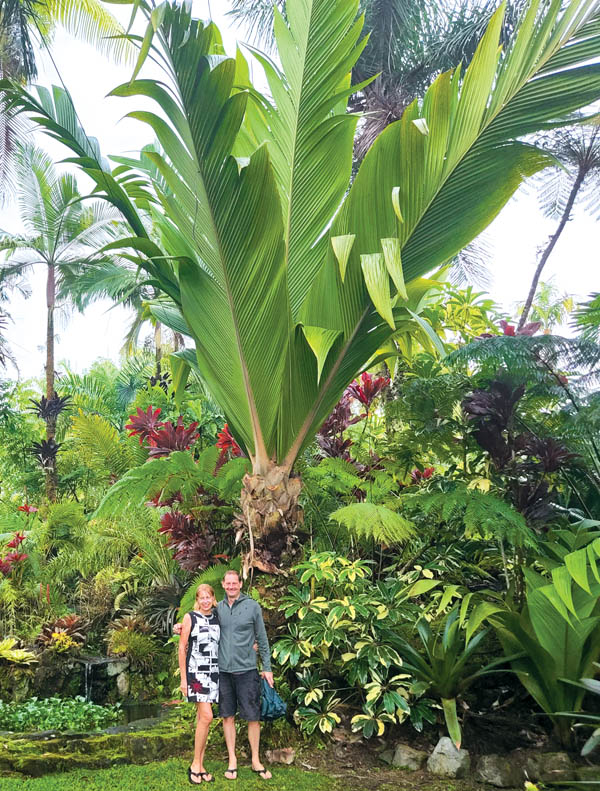
As you cross a smaller stream by way of a carved arch, wander along the moss-covered lava rock walkways, and inhale air perfumed with the scent of orchids, you’ll lose all sense of time and place. A jurassic garden where magical creatures are seemingly beyond the next majestic tree, clad in the ruffly, velvety-soft leaves of Hainan, China’s Alpinia rugosa (tropical shell ginger), you’ll suspect you are returning from another world when you emerge onto the lush lawn at last.
Built to be the late Jerry Hunter’s private retreat, the nearly seven-acre paradise still exudes a sense of serene seclusion. An acclaimed nurseryman, Mr. Hunter established Hilo’s Palms of Paradise Nursery as growing grounds for Rancho Soledad, his California nursery. In collaboration with designer Brian Lievens, he worked to transform this upper Hilo farmland into the botanical dreamscape that Casa de Las Palmas is today. Until his passing in 2012, Mr. Hunter’s garden remained largely a mystery to the public. In 2017, Irene Francis and Lars Woodruffe purchased Casa de Las Palmas from the estate of Mr. Hunter.
“It was love at first sight!” Irene says enthusiastically.
Irene and Lars live on the property, hosting exclusive events. Accompanied by Master, their ebony cat, the couple also leads private tours under verdant canopies of palm leaves and past exotic waterfalls and a shimmering koi pond. Koa, the one-eyed rooster, often joins the revelry, while Marcus, their ginger cat, naps on the lānai.
“The Johannesteijsmannia altifrons is from Malaysia, Borneo, Sumatra, and Thailand,” says Lars, pointing to a palm by the front door that boasts large, triangular leaves. To hear him explain how many consider this very palm to be one of the largest in a private garden, it’s easy to assume that Lars has been studying tropical plants for decades. In reality, everything he and Irene know about the flora is what they’ve learned living at Casa de Las Palmas.
Mastering the Art of Palm Care
New Zealand natives, Irene and Lars spent over 30 years working for the television industry in Auckland, London, New York, and Singapore before they heard the call of Casa de Las Palmas. The couple moved to Hawai‘i Island intent on being stewards of this East Hawai‘i legacy garden, a job that began with clearing the overgrown trails and making major repairs around the garden home, and evolved into a hands-on learning experience.
“It’s been like climbing up the side of Mt. Everest! But we’ve been fortunate to learn from the best,” says Irene of the help they’ve received from the Hawai‘i Island Palm Society, a group of palm enthusiasts who promote the use of palm trees in private gardens and the general landscape, and perpetuate rare and endangered palms by sharing seeds and plants.
“Casa de Las Palmas’ original master gardener, Cristabol, has also been instrumental in teaching us the art of palm care,” says Lars, affirming that he and Irene follow Cristabol around the garden during his weekly rounds.
“And we spend our evenings studying books about palm trees,” says Irene, explaining that there are around 2,600 species of palms, all of which are one of three shapes. Pinnate palms, like the coconut, have feather-like leaflets that are completely separated from each other. Palmate palms have adjacent leaflets or leaf segments that are joined laterally and fan out like the palm of a hand. And costapalmate palms have leaves that land somewhere between pinnate and palmate in shape.
“This palmate is a Kerriodoxa elegans, from the island of Phuket in Thailand,” notes Lars before revealing that the underside of this black-stemmed palm is reflective.
Preserving Exotic and Endangered Palms
Irene and Lars work tirelessly to maintain Casa de Las Palmas’ original glory, lending their own artistic talent to the property’s improvements. Today, this private estate is available for garden tours, film shoots, wedding photography, and as a romantic location for exclusive events, small weddings, and vow renewals.
Catching the eye of some of the world’s most renowned photographers, the vibrant property has been featured in Vogue Mexico and Jason Dewees’ book Designing With Palms, and been the site of a Nike photoshoot and Love Island film shoots.

More importantly, Casa de Las Palmas is an international sanctuary for the preservation of endangered and rare palms, including the Pelagodoxa henryana, which is considered critically endangered.
“Originally from the Marquesas Islands, it’s now almost extinct there,” laments Lars. “At one point there were fewer than 12 adult trees on the islands.”
Discovered in 2005, the Tahina spectabilis is faring slightly better for now, with close to 100 trees in the wild. Fortunately, Irene and Lars were able to grow three of this Madagascar palm from one of the first batches of seeds distributed.
Madagascar stands out as the source of an array of rare and fascinating palms, including the garden’s towering Marojejya darianii and the Dypsis mananjarensis, which is commonly called the “mealy bug palm.”
“See the white, waxy powder on the leaf sheath? It looks like a mealy bug, but those are actually the palm’s scales!” says Irene, clearly impressed by a plant clever enough to divert the attention of actual predators by presenting itself as diseased.
In another colorful corner of the garden stands the spiny Aiphanes horrida. Hailing from South America, this palm is armored in intimidating spikes for protection. Although not deadly, a brush with its spikes comes with extreme pain and a 100% chance of infection.
“Learning these Latin names is definitely a brain teaser,” Lars admits, before launching into an effortless, eloquent introduction to the Borassodendron machadonis. “This palm’s seed is the size of a large grapefruit. It’s undoubtedly the biggest seed in our garden!”
First planted in the 1980s, rare palms from Indonesia already soar overhead, the tallest being Sulawesi’s Pigafetta filaris, standing 100 feet tall. And palms aren’t the only flora that seem to grow brighter and bigger at Casa de Las Palmas. Here, the Anthurium cupulispathum are so enormous that a human head could easily be enveloped in its leaves.
Reaping the Benefit of Hard Work

The ability for Casa de Las Palmas’ plants to flourish can be attributed to the work that Irene and Lars lovingly pour into the garden’s care, paired with an ideal tropical climate. The rainy Hilo weather that the palm trees adore, however, comes at a price. Thriving in the presence of damp, warm conditions, fungus and mold are a threat to the palms.
“To help fight both, we try to give the palms more light and air by pruning all the plants,” Lars says. “We also fertilize, mulch, and weed.”
General maintenance also includes hauling away 1,500 to 3,000 pounds of green waste, which Irene and Lars do every week. In turn, much of the green waste is converted to mulch, which the couple then uses to gradually build the garden’s soil back up. It’s an unending cycle that is not without its challenges.
“The hardest part of owning a huge, tropical garden is the fact that there is never nothing to do!” Irene asserts, before conceding that the hard work is rewarding for many reasons. “The palms’ crowns provide shelter for birds. And the plants’ flowers and fruit attract honeybees searching for food.”
Throughout the garden and across the globe, palm tree preservation and restoration are catalysts for change. The seed of South America’s Phytelephas aequatorialis, or ivory nut palm, is being used as a humane substitute for jewelry once made from elephant’s ivory.
“Perhaps the best part of owning a garden like this is the ability to empty your mind by working in it,” offers Lars. “And those magic moments of finding something new growing or flowering, and the journey of figuring out what it is!” he says of the many plants that self-seed.

Guardians of the Garden
Globally, the main threats to the palm come from loss of habitat by burning and logging for construction, as well as harvesting the trees for palm heart and destroying them for agricultural land.
What’s especially problematic is that almost all palms only have one growing point. As such, they can’t be propagated using common techniques. The palm tree can only be grown from seed, so when the top is cut off for any reason, a new branch or tree will not grow in its place and the palm will die.
It’s assuring to know that at Casa de Las Palmas, the palms are safe from dangers that might otherwise threaten these enchanting plants. And as stewards of the garden, Irene and Lars intend to keep it that way.
“We are certainly grateful to be the current guardians of this beautiful place,” exclaims Irene. “I also think we are all guardians. Every time we visit a beach or take a walk, our responsibility is to leave a place as we find it, so the next person on that path gets to enjoy it as we do!” ❖
For more information: houseofthepalms.com
